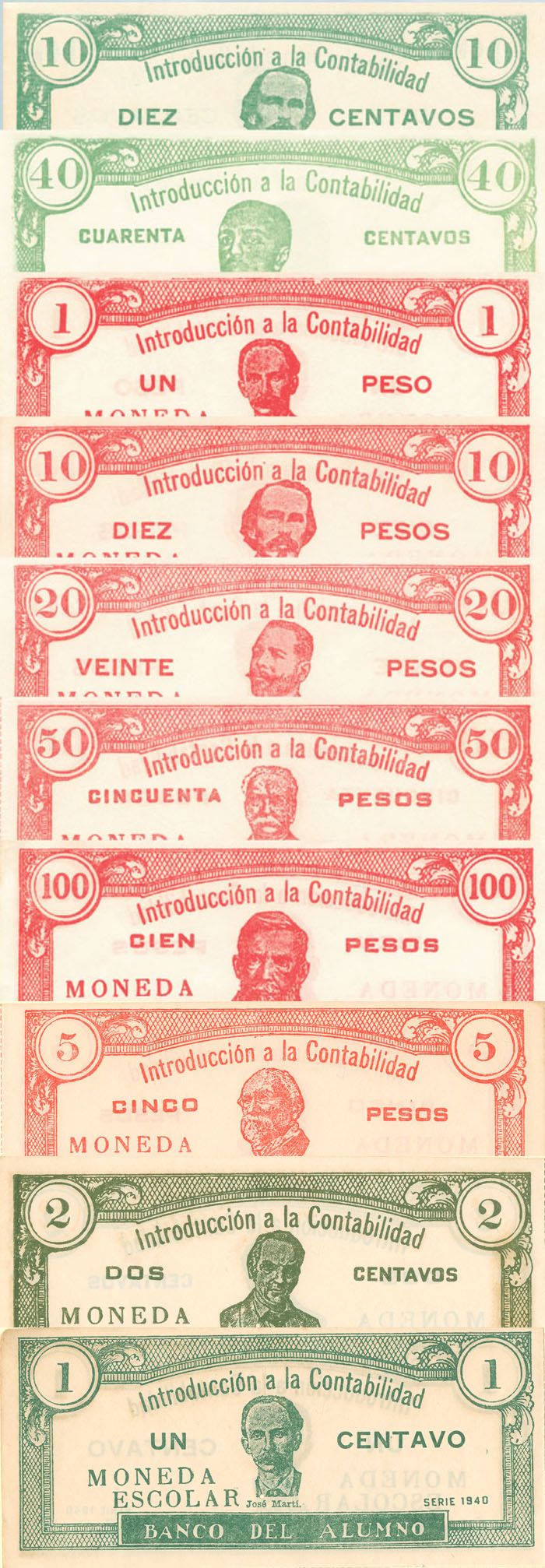Cuba - Educational Set of 10 notes - Foreign Paper Money
Inv# FM1294 Paper Money
1, 2, 5, 10 and 40 Centavos; 1, 10, 20, 50, and 100 Pesos, 1940. Rare! Educational Set.
The Cuban peso also known as moneda nacional, is the official currency of Cuba.
Until 1 January 2021, there were two currencies in use in Cuba, both called peso. One is the "Cuban peso" and the other was the Cuban convertible peso (ISO 4217 code: CUC, often called "dollar" in the spoken language). Both currencies are subdivided into 100 centavos. The CUC was pegged to the US dollar at par, while the CUP was 25 CUP = 1 CUC = US$1, for cash exchanges. Both currencies are not traded internationally, and they cannot be bought in advance outside Cuba. Importation/exportation of CUCs is prohibited.
On 10 December 2020, it was announced that CUCs will start to be withdrawn from circulation from 1 January 2021, leaving the CUP as the only currency in circulation, pegged at US$1 = 24 CUP. From that date, CUCs could only be exchanged in banks or CADECAs, or used in certain shops. This move technically devalued the peso, compared to the "official" 1:1 rate used by Cuban state-owned businesses.
Prior to unification of the currencies on 1 January 2021, Cuban state workers received their basic wages in CUPs, but some also received a portion of their salary in CUCs. Until 2014, most shops accepted payment only in one of CUP or CUC, depending on whether they were selling staple domestic goods or imported goods. From 2014, many state-owned shops began to accept either currency, in preparation for future unification of the two currencies.
CUC coins are distinguishable from CUP coins, as CUC coins have an octagonal shape within the outer round rim. The only exception is the most common CUP coin, the 1 CUP peso, which also has this octagonal shape; while CUC currency shows monuments, and CUP bills have portraits.
Before 1857, Spanish and Spanish colonial reales circulated in Cuba. From 1857, banknotes were issued specifically for use on Cuba. These were denominated in pesos, with each peso worth 8 reales. From 1869, decimal notes were also issued denominated in centavos, with 100 centavos for each peso. In 1881, the peso was pegged to the US dollar at par. The currency continued to be issued only in paper form until 1915, when the first coins were issued.
In 1960, the peso lost value after the United States imposed an embargo against Cuba and the suspended the sugar quota; and Cuba changed the peg from the US dollar to the Soviet ruble (at that time US$1 was worth exactly 4 Soviet rubles). The suspension of the sugar quota was the main economic force driving Cuba to seek out the Soviet Union as a new economic partner.
When the Soviet Union dissolved in 1991, the peso lost much of its value with the exchange rate falling to 125 pesos to the US dollar. Recently, it has fluctuated between 23 and 25 pesos to the US dollar. In 1993, during the period of economic austerity known as the Special Period, the US dollar was made legal tender to encourage hard currency to enter the economy. The US dollar was the currency used to purchase some non-essential goods and services, such as cosmetics, and even staple kinds of food and drink.
In 1994, the convertible peso was introduced at a par with the US dollar, and circulated alongside the US dollar. Cuban businesses used an artificial "official rate" of 1 CUP = 1 CUC = US$1, whilst government-owned Cadecas (Casas de Cambio) exchanged cash at "unofficial" but government-set rates, which were closer to the exchange rates in the black-market.
On November 8, 2004, the Cuban government withdrew US dollars from circulation, citing the need to retaliate against further US sanctions.
From 2014, state-owned shops which had previously sold in CUC, began selling in either currency. The government also introduced other exchange rates used by specific types of businesses.










Ebay ID: labarre_galleries